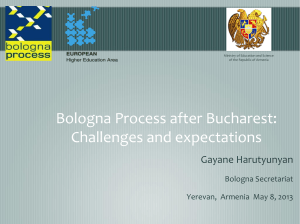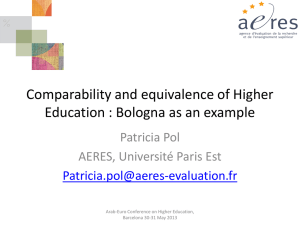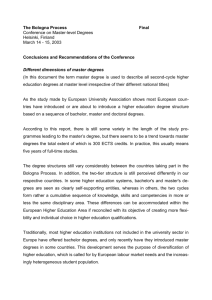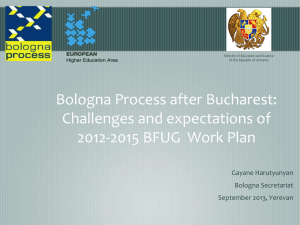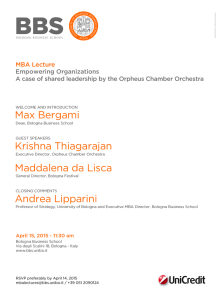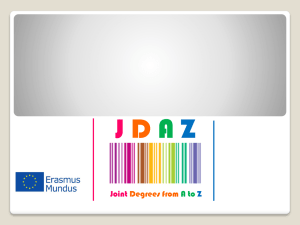PressBriefingForYerevanMCandFourthBPF
advertisement
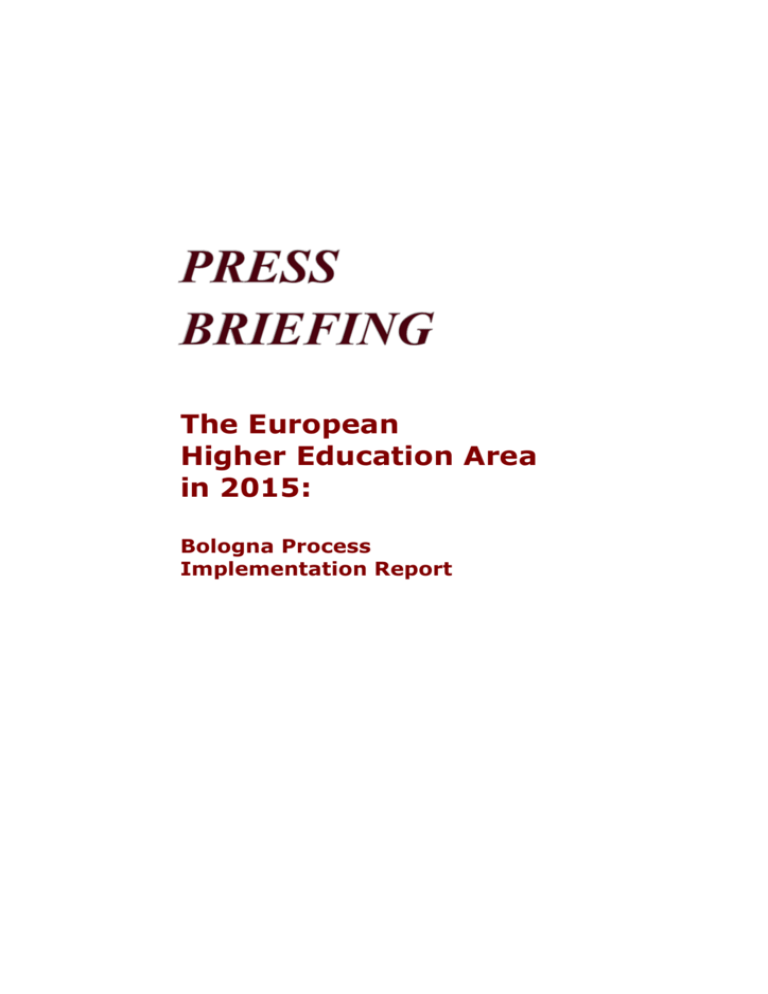
The European Higher Education Area in 2015: Bologna Process Implementation Report INTRODUCTION The Bologna Process The Bologna Declaration was signed in 1999 by ministers responsible for higher education from 29 European countries. However its origins lie a year further back in the Sorbonne Conference and Declaration of 1998. These events and texts set in motion a European cooperation process that has radically changed higher education. Reforms have affected countries within and beyond Europe, and the number of official signatory countries has risen to 47. CONTEXT The Bologna Process Implementation Report 2015 has been prepared for the European Ministerial Conference in Yerevan, Armenia on 14-15 May 2015. It provides a snapshot of the state of implementation of the Bologna Process from various perspectives using data collected in the first half of 2014. It provides both qualitative information and statistical data, and covers all main aspects of higher education reforms aiming at a well-functioning European Higher Education Area (EHEA). The report is a successor to the first Bologna Process Implementation Report (2012) and has been developed through collaboration between the Bologna Follow-up Group (BFUG) and Eurostat, Eurostudent and Eurydice, commonly referred to as 'the data collectors'. Ministers of the 47 countries in the EHEA agreed on the common future priorities of the EHEA but they are facing very different contexts when implementing their higher education policies. The size of student population is very diverse across the EHEA and reflects the demographic characteristics of each country. The EHEA countries show a mixed picture when looking at the changes in the total student population during the periods between some of the recent key milestones of the Bologna process. The total number of students varies between 960 in Liechtenstein and almost 8 million in Russia, a country that takes up slightly more than 21.5 % of the student population in the whole EHEA. The countries of the EHEA also differ largely in the composition of their tertiary student population in terms of the level of education. In almost all the EHEA countries, except Belgium, a majority of tertiary students are enrolled in Bachelor and Master Programmes. Students in Doctoral Programmes account for less than 5% of the student population in 36 EHEA countries. As for the funding of higher education institutions, they are funded predominantly from public sources. However, the levels of public expenditure vary greatly within the EHEA. The changes in annual public expenditure on tertiary education as a percentage of GDP also vary. While in a considerable number of countries the percentage of total public expenditure increased in 2011 as compared to 2005, some countries experienced decreases and the levels of decreases also vary. 2 Yearly Changes in real public expenditure on tertiary education between 2008 and 2012, (price index 2005=100) 3 DEGREES AND QUALIFICATIONS ________________________________________________ Adoption of a system of easily readable and comparable degrees and the establishment of a two-cycle system of bachelor and master degrees are core action lines of the Bologna Declaration itself. Moreover, in 2012 in Bucharest, the ministers acknowledged that significant progress had been made and stated that they would “strive for more coherence between [their] national policies, especially in completing the transition to the three-cycle system, the use of ECTS credits, the issuing of Diploma Supplements, the enhancement of quality assurance and the implementation of qualifications frameworks, including the definition and evaluation of learning outcomes” (Bucharest Communiqué 2012, p. 1). It is evident that the EHEA has evolved towards a more common and much more understandable structure of degrees. There is, however, no single model of first-cycle programmes in the EHEA. Most countries combine programmes of 180 ECTS and 240 ECTS. In some countries, the number of (usually professional) programmes using the 210 ECTS model is significant as well. In the second cycle, the most common model is 120 ECTS with two-thirds of programmes following this workload. As for the third-cycle programmes, the use of ECTS is growing over time. In 2014, 21 countries use ECTS throughout doctoral studies and an additional 14 countries for taught elements only. Percentage of students enrolled in programmes following the Bologna three-cycle structure, 2008/09 and 2011/12 Short-cycle qualifications are the exception to the rule of convergent development in degree structures. They have a different status in different countries, being recognized in some as a part of higher education, in others as part of post-secondary vocational education or even as part of secondary education. Access to the next cycle (according to the Lisbon Recognition Convention definition) is generally smooth. The share of first-cycle students continuing studies in a second cycle programme after graduation from the first cycle varies among the countries. While in some countries only 1-25 % of first cycle graduates continue to the second cycle, in other countries this figure may reach 75-100 %. The Report shows that the use of Bologna tools – ECTS, Diploma Supplement, and national 4 qualifications frameworks – continues to grow and develop; yet their usage is not systematic and a number of shortcomings remain. While 38 countries are in the 'green zone' regarding the implementation of national qualifications frameworks, 10 countries still have not started the implementation at programme and institution level, and some of them show no progress since 2012. A majority of countries still face challenges in including non-formal qualifications within national higher education frameworks self-certified against the QFEHEA. There is progress in ECTS implementation since 2012. Using ECTS for both accumulation and transfer is implemented to some extent practically everywhere. Linking credits with learning outcomes has progressed as well, but more efforts are needed. Regarding the Diploma Supplement, there is improvement compared to 2012. However, two thirds of countries have failed to fulfill all the requirements – that the Diploma Supplement should be issued to every graduate, automatically, in a widely spoken European language and issued free of charge. The least achieved requirement is the automatic issuing of Diploma Supplements. The Report also finds continuing problems regarding recognition of qualifications. In more than two thirds of countries, higher education institutions make the final decision upon recognition of the foreign qualifications, but recognition of credits gained abroad is fully in the hands of higher education institutions. Since recognition of credits is done without consulting ENIC/NARIC centres, and recognition of foreign qualifications is carried out by higher education institutions without advice of ENIC/NARIC centres in 1/3 of countries, it is important to improve the knowledge and capacity of higher education institutions to undertake this role. Finally, the Report finds that nearly three quarters of qualifications from at least some of the EHEA countries are treated equally as national qualifications. This demonstrates that automatic recognition at education system level is feasible and possible and as a long-term goal of the EHEA, it can be achieved if the political commitment is pursued. 5 QUALITY ASSURANCE ________________________________________________ The aspiration to improve the quality of higher education provision throughout the EHEA lies at the core of the Bologna Process, and has underpinned major developments in quality assurance during the last 15 years. When the European Standards and Guidelines (ESG) for quality assurance were adopted in 2005, this gave a boost to European cooperation in the domain. The European Association for Quality Assurance in higher education (ENQA) established in 2000 provides a thriving forum for cooperation and engagement among quality assurance agencies, requiring its members to adhere to the ESG. The European Quality Assurance Register for Higher Education (EQAR) was established three years later, and by September 2014, 32 agencies in 15 countries were listed on the Register. This report provides strong evidence that quality assurance continues to be an area of dynamic evolution that has been spurred on through the Bologna process and the development of the EHEA. While information on internal quality assurance is necessarily limited, the findings indicate that the trend for higher education institutions to develop their own strategies for quality enhancement is spreading and increasing. Equally the public accountability and transparency requirements in quality assurance systems are evolving, with a significant increase in the number of countries reporting that all institutions publish the outcomes of quality assurance evaluations, even when negative. External quality assurance systems are now practically ubiquitous in the EHEA and the main issue is whether the system is producing effective results and working in compliance with the ESG. In this respect, there is still progress to be made, particularly regarding student participation in quality assurance. One of the major trends and commitments made in the context of the Bologna process is to open up the possibility for higher education institutions to be evaluated by foreign agencies, provided that these are working in full conformity with the ESG. While there is evidence that higher education institutions are increasingly taking advantage of opportunities to work with agencies from other countries, national reforms in this area are slow-moving. Indeed since the renewed commitments made in the Bucharest Communiqué, only two countries – adding to 10 where this was already possible – have followed up with significant legislative reform enabling higher education institutions to work with EQAR-registered quality assurance agencies. Countries encouraging national quality assurance agencies to register with EQAR and become a member of ENQA, 2013/14 6 SOCIAL DIMENSION IN HIGHER EDUCATION ________________________________________________ The social dimension is understood as the process of widening access to higher education so that the student body "entering, participating in and completing higher education at all levels should reflect the diversity of our populations" and the Bologna texts also emphasise the "importance of students being able to complete their studies without obstacles related to their social and economic background" (London Communiqué 2007, p. 5). While some progress can be noted since the 2012 Bologna Process Implementation Report, the analysis clearly shows that the goal of providing equal opportunities to quality higher education has not been reached yet. With regard to gender, some imbalances have reduced over time but nevertheless continue to exist in most countries and across the EHEA as a whole and between different fields of study as well. In some fields, such as teacher training or social services, men are strongly underrepresented. In other fields, such as computing or engineering, women are strongly underrepresented. Policies aimed at achieving gender balance in higher education are therefore likely to be most effective if they take study-field-specific imbalances into account. Moreover, the available data shows that an immigration background is negatively associated with higher education attainment. Similarly, the educational background of parents continues to have a strong impact on tertiary education attainment. Being aware of those (and other) imbalances, almost all higher education systems reflect the objective of widening participation in their higher education policy, and more than 70 % of the systems claim to do so through a set of concrete measures. National policy approaches to widening participation in higher education, 2013/14 As far as alternative access to higher education is concerned, the overall picture across the EHEA looks very similar to the situation described in the previous implementation report. In 22 higher education systems (most of them in Western Europe) at least one such alternative 7 route to higher education exists, while in the remaining 25 systems providing data access to higher education still depends on the possession of an upper secondary school leaving certificate (general or vocational). Some progress can be noted concerning the recognition of prior non-formal and informal learning but still a lot of work remains to be done, with regard to policies, procedures, implementation and monitoring. The social dimension is also inextricably connected with national practices regarding financial arrangements. Fees (tuition and administrative fees combined) are widespread, with only seven education systems not levying any student contributions. Yet, there is a large variation between higher education systems regarding the proportion of students paying fees (from nearly no one to everyone) as well as the amount of fees they need to pay (from nearly zero to more than 100 % of the GDP per capita). Countries also rely on different combinations of forms of student support, and the proportion of students receiving such support also varies widely. The extent to which systems are able to meet students' needs, providing them with adequate services to support them along their study paths is also an essential issue for the social dimension. The report indicates academic and/or career guidance services are commonly provided by higher education institutions in all 48 higher education systems for which data is available. In two-thirds of the systems, higher education institutions also provide psychological guidance services. Special services for students with disabilities also exist in a number of cases. In all systems, support services are not only offered to enrolled students but also to prospective students. While this widespread existence of student services is certainly a positive development, the available data does not allow the quality and effectiveness of the services provided to be assessed, nor the extent to which services are accessible to all students. 8 LIFELONG LEARNING ________________________________________________ Lifelong learning continues to be a challenging concept and is subject to various local, regional or national interpretations. Lifelong learning is a recognised mission in all higher education institutions in most of the EHEA countries. Lifelong learning as a recognized mission of higher education institutions, 2013/14 Higher education institutions in the EHEA are autonomous in deciding if they wish to offer other types of programme than full-time studies; yet, when asked, most countries report of part-time study modes. Moreover, higher education institutions have a well-established flexible course provision in many countries, offering various types of distance and e-learning, in addition to part-time studies. In the EHEA the financing of lifelong learning is fragmented, but the majority of funding in many countries comes from the general public education budget, with additional funding from private contributions from students and businesses. In most countries, part-time students do not make higher contributions to the cost of their education than full-time students, although in eight countries they do. Moreover, the financial support for part-time students is in some countries more limited than for their full-time counterparts. Indeed the two issues are often related, as in some countries where part-time students need to make higher financial contributions; the support they receive is lower or does not exist. Hence, in these countries there are no financial incentives to study part-time, so students wishing to study more flexibly may find it difficult to do so. 9 Impact of formal student status on financial arrangements related to higher education studies, 2013/14 Looking at the degree of participation of students aged 30 and over in the total student population (in particular mature students and delayed transition students) in formal higher education programmes, the report shows that situations vary significantly. Participation rates of mature students are as low as 2 % of the total student population in some countries (Russia, Azerbaijan and Georgia). At the other end of the spectrum are the Nordic countries and the United Kingdom, where mature students represent around one third of the total student population. This suggests that EHEA countries address the needs and expectations of “lifelong learners” with very different degrees of intensity. % of students enrolled in tertiary education, total and by gender, 30 or more years old, 2011/12 10 EFFECTIVE OUTCOMES AND EMPLOYABILITY ________________________________________________ Higher education attainment levels are generally on the rise in the EHEA, and this trend is clearly to be welcomed given the fast-evolving knowledge economy challenges that are being faced. Yet many students still drop out of higher education without completing their studies. Though data availability and comparability still pose challenges, available completion rates range from 48 % to 88 %. Completion rates in tertiary type A programmes (%), 2011 Policy interventions to improve performance tend to focus primarily on giving financial incentives to students to finish their studies on time. Providing specific guidance and support to those first-year students who are most likely to drop out of higher education is less widespread. Moreover, very few countries focus on the completion rates of under-represented groups. Data show that higher education graduates have been hit hard by the economic crisis in terms of their employment prospects. Unemployment ratios have grown proportionally more for them than for their peers with lower levels of education; their income advantages have slightly decreased; and their over-qualification rates have increased in the period between 2010 and 2013. And while unemployment ratios are still the lowest for young people with high educational attainment in most countries, this is not true everywhere within the EHEA. In fact, in one third of the countries with available data, higher education graduates do not have the most secure position in the labour market. In a few countries this is linked to the economic crisis; in others it is due to the structure of the economy and the relatively small higher education sector. Nevertheless, in this latter group, which includes former Soviet Union member countries and countries in the Balkans, unemployment ratios of the highly educated are now decreasing. 11 Unemployment ratio of people aged 20-34 by educational attainment level (%), 2013 All these developments highlight the need for higher education policy-makers to (re-)focus attention on the employability of graduates. Currently, while almost all EHEA countries recognise employability as a policy concern, systematic efforts including several policy elements are still not applied everywhere. Nevertheless, more and more countries introduce new policies and monitoring tools such as graduate surveys in order to improve graduate employment. 12 INTERNATIONALISATION AND MOBILITY ________________________________________________ EHEA countries present very different situations with regard to internationalisation and mobility, especially when looking at their individual mobility flows and the level of engagement in internationalisation activities. Most countries encourage the internationalisation of higher education through their steering documents. However, more than half of them lack a national internationalisation strategy or guidance to the various stakeholders involved in the internationalisation process. Higher education institutions in many countries also lack comprehensive internationalisation strategies, although they are increasingly engaged in internationalisation activities such as joint programmes/degrees, MOOCs and cross-border cooperation in research. Many countries have not adopted national quantitative targets for different forms of mobility. National strategies for internationalization of higher education, 2013/14 Nevertheless, there is no doubt that the trend for internationalisation is growing, and that this offers great potential for higher education institutions in the EHEA. However, lack of funding as well as inflexible national legal frameworks may hinder development in some countries. Student mobility rates show slight increases since the 2012 Bologna Process Implementation Report, but still only a minority of students benefit from such experience and mobility for under-represented groups would need greater attention. Both the incoming and the outward degree mobility rates within the EHEA are below 5 % for the vast majority of countries. When looking at degree mobility flows with non-EHEA countries, students from outside the EHEA make up more than 5 % of the total student population in only four countries, while in many this proportion is less than 1 %. Overall, the average rate of incoming degree mobile students (from EHEA and non-EHEA countries) is relatively low, reaching 4.4 % of total enrolments. This is a very small increase from 4% in 2008/09. 13 Number of incoming degree tertiary education mobile students from outside the EHEA, by country of destination, 2011/12 The rate of outward mobility (students undertaking a degree in a non-EHEA country) is extremely low, the weighted average of the EHEA countries reaching only 0.33 %, a figure that has not change since 2008/09. The concept of 'balanced' mobility is increasingly discussed, yet hardly any country can claim to have genuinely balanced degree mobility. Even when flows reach similar numbers, the countries of origin/destination differ significantly. It is not possible at the moment to report accurately on whether the EHEA collective target of 20 % mobility by 2020 can be reached or not, as comprehensive and harmonised data collection is not yet fully in place – particularly for credit mobility. A number of obstacles that prevent students from benefitting from mobility periods abroad have been identified in the Report. Funding is perceived by ministries and students alike as the biggest obstacle to increased mobility. The portability of financial student support is clearly one important measure to address this concern, but only a minority of countries currently ensure full portability for their students. Data limitations pose even more significant challenges in evaluating the current situation for staff mobility. For both student and staff mobility, it will be essential to focus not only on numbers, but also on the quality of mobility. This implies investing in information services, monitoring experience, ensuring that recognition and evaluation processes operate fairly, and making changes in light of experience. Improved monitoring of the impact of measures taken to remove obstacles to mobility will also be crucial if optimal mobility flows are to be achieved. 14
